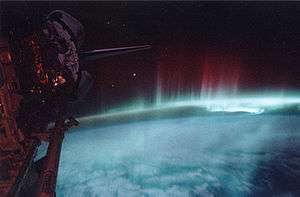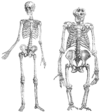Monkeys and apes in space

Before humans went into space, several other animals were launched into space, including numerous primates, so that scientists could investigate the biological effects of space travel. The United States launched flights containing primate cargo primarily between 1948-1961 with one flight in 1969 and one in 1985. France launched two monkey-carrying flights in 1967. The Soviet Union and Russia launched monkeys between 1983 and 1996. Most primates were anesthetized before lift-off. Overall thirty-two monkeys flew in the space program; none flew more than once. Numerous back-up monkeys also went through the programs but never flew. Monkeys and apes from several species were used, including rhesus monkeys, cynomolgus monkeys, squirrel monkeys, pig-tailed macaques, and chimpanzees.
United States
.jpg)

The first ever primate astronaut was Albert, a rhesus monkey, who on June 11, 1948, rode to over 63 km (39 mi) on a V2 rocket. Albert died of suffocation during the flight.[1][2][3]
Albert was followed by Albert II who survived the V2 flight but died on impact on June 14, 1949, after a parachute failure.[2] Albert II became the first monkey in space as his flight reached 134 km (83 mi) - past the Kármán line of 100 km taken to designate the beginning of space.[4] Albert III died at 35,000 feet (10.7 km) in an explosion of his V2 on September 16, 1949. Albert IV on the last monkey V2 flight died on impact on December 8 that year after another parachute failure.[2] His flight reached 130.6 km. Alberts I, II, and IV were rhesus monkeys while Albert III was a cynomolgus monkey.
Monkeys later flew on Aerobee rockets. On April 18, 1951, a monkey, possibly called Albert V, died due to parachute failure. Yorick, also called Albert VI, along with 11 mouse crewmates, reached 236,000 ft (72 km) and survived the landing, on September 20, 1951, the first monkey to do so (the dogs Dezik and Tsygan had survived a trip to space in July of that year), although he died 2 hours later. Two of the mice also died after recovery; all of the deaths were thought to be related to stress from overheating in the sealed capsule in the New Mexico sun while awaiting the recovery team.[2] Albert VI's flight surpassed the 50 mile boundary the U.S. used for spaceflight but was below the international definition of space. Patricia and Mike, two cynomolgus monkeys, flew on May 21, 1952, and survived, but their flight was only to 26 kilometers.
On December 13, 1958, Gordo, also called Old Reliable, a squirrel monkey, survived being launched aboard Jupiter AM-13 by the US Army.[4] He was killed due to mechanical failure of the parachute recovery system in the rocket nose cone.[4]

On May 28, 1959, aboard the JUPITER AM-18, Able, a rhesus monkey, and Miss Baker, a squirrel monkey flew a successful mission. Able was born at the Ralph Mitchell Zoo in Independence, Kansas.[5] They travelled in excess of 16,000 km/h, and withstood 38 g (373 m/s2). Able died June 1, 1959, while undergoing surgery to remove an infected medical electrode, from a reaction to the anesthesia. Baker became the first monkey to survive the stresses of spaceflight and the related medical procedures. Baker died November 29, 1984, at the age of 27 and is buried on the grounds of the United States Space & Rocket Center in Huntsville, Alabama. Able was preserved, and is now on display at the Smithsonian Institution's National Air and Space Museum. Their names were taken from the US military phonetic alphabet.
On December 4, 1959, Sam, a rhesus monkey, flew on the Little Joe 2 in the Mercury program to 53 miles high.[4] Miss Sam, also a rhesus monkey, followed in 1960, on Little Joe 1B although her flight was only to 8 mi (13 km) in a test of emergency procedures. Ham and Enos also flew in the Mercury program but they were chimpanzees. The names 'Sam' and 'Ham' were acronyms. Sam was named in homage to the School of Aerospace Medicine at Brooks Air Force Base in San Antonio, Texas. The name 'Ham' was taken from Holloman Aerospace Medicine at Holloman Air Force Base, New Mexico.
Goliath, a squirrel monkey, died in the explosion of his Atlas rocket on November 10, 1961. A rhesus monkey called Scatback flew a sub-orbital flight on December 20, 1961, but was lost at sea after landing.
Bonny, a pig-tailed macaque, flew on Biosatellite 3, a mission which lasted from June 29 to July 8, 1969. This was the first multi-day monkey flight, but came after longer human spaceflights were common. He died within a day of landing.
Spacelab 3 on the Space Shuttle flight STS-51-B featured two squirrel monkeys named No. 3165 and No. 384-80. The flight was from April 29 to May 6, 1985.
France
France launched a pig-tailed macaque named Martine on a Vesta rocket on March 7, 1967, and another named Pierette on March 13. These suborbital flights reached 243 km (151 mi) and 234 km (145 mi), respectively. Martine became the first monkey to survive more than a couple of hours after flying above the international definition of the edge of space (Ham and Enos were chimpanzees).
Soviet Union and Russia
The Soviet/Russian space program in the Bion program in 1980s and 1990s[6] satellites used only the rhesus species. The names of the monkeys started with each letter of the Russian alphabet sequentially (А, Б, В, Г, Д, Е, Ж, З...). Most of the animals survived, except for a single fatality, after which the program was cancelled.
- The first Soviet monkeys, Abrek and Bion, flew on Bion 6. They were aloft from December 14, 1983 – December 20, 1983.[7]
- Next came Bion 7 with monkeys Verny and Gordy from July 10, 1985 – July 17, 1985.[8]
- Then Dryoma and Yerosha on Bion 8 from September 29, 1987 – October 12, 1987.[9] After returning from space Dryoma was presented to Cuban leader Fidel Castro.
- Bion 9 with monkeys Zhakonya and Zabiyaka followed from September 15, 1989 to September 28, 1989.[10] They hold the monkey in space endurance record at 13 days, 17 hours in space.
- Monkeys Krosh and Ivasha flew on Bion 10 from December 29, 1992 to January 7, 1993.[11] Krosh produced offspring, after rehabilitation upon returning to Earth.
- Lapik and Multik were the last space monkeys before Iran flew one in 2013. They flew aboard the Bion 11 mission from December 24, 1996, to January 7, 1997.[12] Multik died following inhalation of vomitus while anesthetized for US biopsy sampling on January 8. Lapik almost died during the identical procedure. These two incidents, combined with the bad reaction to post-flight anesthesia by the US monkey (Able) 4 days after return to Earth, were never followed up, as a potential impact of spaceflight contraindicating anesthesia during or shortly after spaceflight. Further US support of the Bion program was cancelled.[12]
Argentina
On December 23, 1969, as part of the 'Operación Navidad' (Operation Christmas), Argentina launched Juan (a tufted capuchin, native to Argentina's Misiones Province) using a two-stage Rigel 04 rocket. It ascended perhaps up to 82 kilometers and then was recovered successfully.[13][14][15] Other sources give 30, 60 or 72 kilometers.[16][17] All of these are below the international definition of space (100 km). Later, on the February 1, 1970 the experience was repeated with a female monkey of the same species using a X-1 Panther rocket. Although it reached a higher altitude than its predecessor, it was lost after the capsule's parachute failed.
Iran
On January 28, 2013, AFP and Sky News reported that Iran sent a monkey in a "Pishgam" rocket to a height of 72 miles (116 km) and retrieved "shipment".[18][19] The Iranian media gave no details on the timing or location of the launch. After the launch there were many doubts as to the veracity of the Iranian claims, since the before and after flight pictures clearly showed different monkeys.[20] The doubt and confusion was caused due to the publishing of an archive photo from 2011 by the Iranian Student News Agency (ISNA). According to Jonathan McDowell, a Harvard astronomer, "They just mixed that footage with the footage of the 2013 successful launch."[21]
On December 14, 2013, AFP and BBC reported that Iran again sent a monkey to space and safely returned that monkey from space.[22][23]
See also
- Laika
- Gordo (space monkey)
- Soviet space dogs
- Ham the Chimp
- Animals in space
- Space exploration
- Captain Simian & the Space Monkeys (1996 television series)
- Space Chimps (2008 film)
- One Small Step: The Story of the Space Chimps (2008 documentary)
References
- ↑ "V2 Chronology", Encyclopedia Astronautica.
- 1 2 3 4 "The Beginnings of Research in Space Biology at the Air Force Missile Development Center, 1946-1952". History of Research in Space Biology and Biodynamics. NASA. Retrieved January 31, 2008.
- ↑ "V-2 Firing Tables". White Sands Missile Range. Archived from the original on January 25, 2008. Retrieved January 31, 2008.
- 1 2 3 4 Beischer, DE; Fregly, AR (1962). "Animals and man in space. A chronology and annotated bibliography through the year 1960.". US Naval School of Aviation Medicine. ONR TR ACR-64 (AD0272581). Retrieved June 14, 2011.
- ↑ "Kansan among first to go to space", Wichita Eagle and Kansas.com, March 22, 2010.
- ↑ "The Cosmos Biosatellite Program".
- ↑ "Bion 6 (Cosmos 1514)".
- ↑ "Bion 7 (Cosmos 1667)".
- ↑ "Bion 8 (Cosmos 1887)".
- ↑ "Bion 9 (Cosmos 2044)".
- ↑ "Cosmos 2229 (Bion 10)".
- 1 2 "Life Sciences Data Archive, Bion 11".
- ↑ (Spanish) Documentary on Argentine monkey Juan: ARGENTINA - 4TO PAIS EN LLEGAR AL ESPACIO (Youtube), Trailer del documental "Juan, el primer astronauta argentino" (Youtube)
- ↑ [40 years commemoration] (Spanish) La Voz Del Interior: Hace 40 años, el primer “argentino” llegaba al espacio, Lucas Viano, December 19, 2009
- ↑ [40 years commemoration] (Spanish) Pagina 12: Un pequeño salto para el mono, Leonardo Moledo, December 30, 2009
- ↑ "Argentina y la Conquista del Espacio". Taringa!. Retrieved 2014-07-31.
- ↑ http://www.mincyt.cba.gov.ar/site/fabricamilitar/19551993/19551993_09h.html
- ↑ Gizmodo: Iran Just Sent a Monkey Into Space, Jamie Condliffe, January 28, 2013
- ↑ Sky News: Iran Space Monkey: Primate 'Sent Into Orbit', January 28, 2013
- ↑ Rob Williams (2013-02-01). "Was Iran's monkey in space launch faked? Before and after pictures of space-travelling simian appear to show different animals - Middle East - World". The Independent. Retrieved 2014-07-31.
- ↑ Kamali, Saeed (2013-02-03). "Let's get the facts straight about Iran's space monkey | World news". theguardian.com. Retrieved 2014-07-31.
- ↑ "International News | World News - ABC News". Abcnews.go.com. 2014-07-13. Retrieved 2014-07-31.
- ↑ "BBC News - Iran 'sends monkey to space for second time'". Bbc.co.uk. 2013-12-14. Retrieved 2014-07-31.
Further reading
- Animals In Space: From Research Rockets to the Space Shuttle, Chris Dubbs and Colin Burgess, Springer-Praxis Books, 2007
External links
- ape-o-naut
- NPR article on the 50th anniversary of Able and Baker's flight
- A humorous look at monkey astronaut names
- Monkey astronauts
- One Small Step: The Story of the Space Chimps Official Documentary Site
- Argentina and the Conquest of Space (Spanish)

